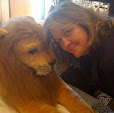From Luguvallium in the west to Segedunum in the east, the Wall ran, leaping along with the jagged contours of the land; a great gash of stone-work, still raw with newness. Eighty miles of fortresses, mile-castles, watch-towers, strung on one great curtain wall, and backed by the vallum ditch and the coast-to-coast Legionary road; and huddled along its southern side, the low sprawl of wine-shops, temples, married quarters, and markets that always gathered in the wake of the Legions. A great and never-ceasing smother of noise: voices, marching feet, turning wheels, the ring of hammer on armourer's anvil, the clear calling of trumpets over all. This was the great Wall of Hadrian, shutting out the menace of the North.
This is the beginning of chapter 11 of The Eagle of the Ninth, by Rosemary Sutcliff, and part of my Northumberland reading project, in prep for my walk along Hadrian's Wall this summer, and it is precisely why I wanted to read the book in the first place. There is a marvelous sense of place throughout the book, as the hero, Marcus Aquila, travels from Exeter (Isca Dumnoniorum) in the south to Silchester (Calleva Atrebatum), up to Chilurnium (on the Wall near Corbridge) and then on to Caledonia (the Highlands of Scotland).
According to Wikipedia:
The Eagle of the Ninth is linked by the Aquila family dolphin ring and listed here in fictional chronological order. (They were not written as a series by the author.)
- The Eagle of the Ninth
- The Silver Branch
- Frontier Wolf
- The Lantern Bearers
- Sword at Sunset
- Dawn Wind
- Sword Song
- The Shield Ring
I enjoyed The Eagle of the Ninth immensely--I found it in the YA section of my library, but I didn't let that throw me off. I loved both the hero, Marcus, a young Roman Centurion from Etruria who comes to live with his uncle in Calleva after he is badly injured in a battle at Isca Dumnoniorum. There he meets and saves a young Briton gladiator, Esca, makes him his slave, and then makes him his friend.
Together they go on a quest to find out what happened to the Ninth Legion, which marched into the mists of the north and never marched back. It was a first rate historical adventure story and I learned a lot about Roman Britain, the customs and religions of both the conquering Romans and the rebellious Britons, the landscape, and the smell of the air and the feel of the landscape. I will definitely read a few more in the series if not all of them, and I'm looking forward to the movie version, The Eagle, which came out in 2011.
I found myself referring repeatedly to the internet for help with Roman site names, although Sutcliff did provide a map at the beginning of the book and a list of place names at the end. Here's one that I liked.




Great post! My copy of the book didn't have a list of place names - it would have been helpful as I had to keep checking the internet too. I like the map of Roman Britain you found. I enjoyed the book very much too and glad you did as well. I really must visit the Wall this year!
ReplyDeleteThis sounds so good. Rome seems so close to modern day civilization yet so far. Fiction relating to that civilization seems to pique my interest.
ReplyDeleteI think that it is really interesting and enlightening the way in which you read to prepare you for future treks Jane.
I have to admit, I know very little about this time period, but you've got me wanting to know more about the Ninth Legion. I find these unsolved historical mysteries very intriguing. :)
ReplyDeleteWhat an interesting map. I have been studying it. Both of the walls fascinate me. I'm glad you've made progress on your readings about it. I will check for the movie The Eagle ... thx
ReplyDeleteAs a fan of historical adventure genre, I enjoyed reading The Eagle of the Ninth. Thank you for mentioning the other similar books by Rosemary Sutcliff. They are on my list now.
ReplyDelete